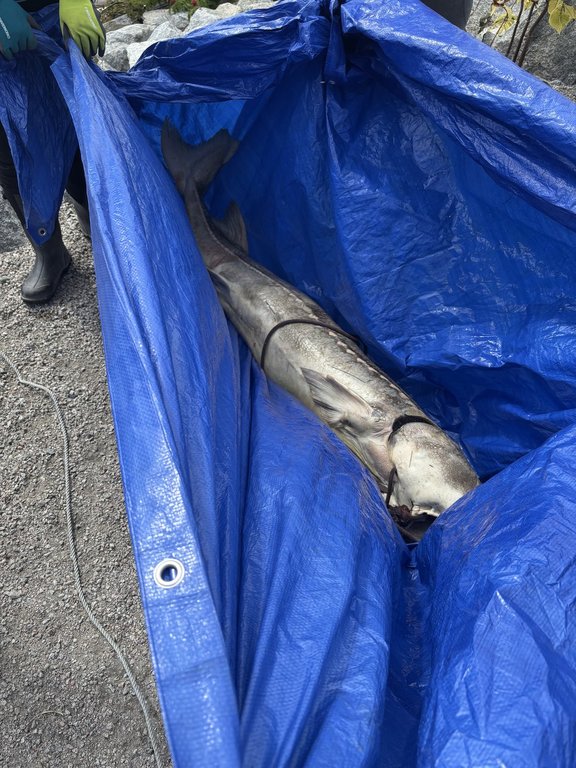Science
Tsawwassen First Nation Launches Research Into Sturgeon Deaths

The Tsawwassen First Nation is investigating a troubling increase in sturgeon deaths along the Fraser River in British Columbia. Recently, the carcass of a sturgeon, measuring approximately 1.6 meters, was retrieved from the riverbank in Richmond, one of many that have washed ashore in recent weeks. This incident is part of a larger effort to understand the causes behind these mortality events and to inform conservation strategies.
Biologist Kelly Scott, who is leading the research, highlighted that sturgeons are ancient creatures, with a lineage dating back around 200 million years. Their recent deaths raise significant concerns about environmental changes affecting their habitats. “Residents near New Westminster have reported seeing multiple sturgeon floating downstream, which is alarming,” Scott stated.
According to the British Columbia Ministry of Land, Water and Resource Stewardship, there has been a noticeable rise in sturgeon mortality this year. The ministry confirmed that since July 2024, there have been reports of 71 dead sturgeon across the province, with 65 of those found in the lower Fraser River. Notably, 49 of these deaths occurred in the past four weeks, compared to 42 total reported mortalities in the lower Fraser for the entire year of 2023.
Research Initiatives and Environmental Factors
White sturgeon are among the largest fish species in the world, reaching lengths of up to six meters and living over 100 years. They hold cultural and nutritional significance for First Nations, including the Tsawwassen, who historically harvested them. In 1994, British Columbia prohibited the harvest of sturgeon, a decision supported by First Nations across the region. Although catch-and-release fishing remains permitted in the lower Fraser, the recent surge in dead sturgeon coincides with a rare opening for sockeye salmon fishing in the area.
Scott emphasized that multiple factors contribute to sturgeon mortality, including climate change and habitat degradation. Rising river temperatures pose a significant threat, as sturgeons require cooler water to thrive. “With fewer shaded areas along the river, these fish lack the thermal refuge they need,” she explained. Additionally, sturgeons under stress are more vulnerable to injuries, particularly from fishing nets.
To address these concerns, the Tsawwassen First Nation aims to collect 20 sturgeon carcasses for research. The team has developed a plan to attach electronic trackers to some of the collected carcasses, allowing them to monitor movement and assess habitat conditions across different seasons. Scott mentioned, “We want to explore various scenarios, including different weather conditions and locations along the river.”
Collaboration and Future Directions
In collaboration with a researcher from the University of British Columbia, the team is also investigating environmental genomics to analyze DNA and RNA from the river’s ecosystem. This research may provide insights into sturgeon behavior and stress levels, which are crucial for understanding their declining populations.
The provincial government posits that a combination of natural and anthropogenic factors could be behind the increased mortality rates. The Fisheries and Oceans Canada department reported that water temperatures in the Fraser River surpassed 20 degrees Celsius during the summer months, increasing the risks of stress and mortality for sturgeon. While fishing activity may correlate with the rise in reported deaths, officials noted that there is no direct evidence linking the recent recreational salmon fishery to sturgeon fatalities.
Sturgeon populations are protected under federal species-at-risk legislation, with certain populations classified as endangered since 2006. Although the lower Fraser sturgeon population is assessed as threatened, it has not yet been granted formal protection status. Anglers are required to obtain a specific conservation license for catch-and-release fishing in this area, and guidelines stress the importance of minimizing harm to the fish.
In 2021, British Columbia initiated a management plan for white sturgeon across the Fraser River basin, involving a steering committee that includes both provincial and First Nations representatives. The collaborative approach aims to ensure the survival of this iconic species while addressing the challenges posed by environmental changes and human activities.
As the Tsawwassen First Nation continues its research, the hope is that these efforts will lead to a better understanding of the factors contributing to sturgeon mortality and inform strategies to protect this ancient fish for future generations.
-

 Lifestyle3 weeks ago
Lifestyle3 weeks agoWinnipeg Celebrates Culinary Creativity During Le Burger Week 2025
-

 Health1 month ago
Health1 month agoMontreal’s Groupe Marcelle Leads Canadian Cosmetic Industry Growth
-

 Science1 month ago
Science1 month agoMicrosoft Confirms U.S. Law Overrules Canadian Data Sovereignty
-

 Education1 month ago
Education1 month agoRed River College Launches New Programs to Address Industry Needs
-

 Technology1 month ago
Technology1 month agoDragon Ball: Sparking! Zero Launching on Switch and Switch 2 This November
-

 Science1 month ago
Science1 month agoTech Innovator Amandipp Singh Transforms Hiring for Disabled
-

 Technology1 month ago
Technology1 month agoGoogle Pixel 10 Pro Fold Specs Unveiled Ahead of Launch
-

 Science1 month ago
Science1 month agoChina’s Wukong Spacesuit Sets New Standard for AI in Space
-

 Technology1 month ago
Technology1 month agoWorld of Warcraft Players Buzz Over 19-Quest Bee Challenge
-

 Science1 month ago
Science1 month agoXi Labs Innovates with New AI Operating System Set for 2025 Launch
-

 Business4 weeks ago
Business4 weeks agoDawson City Residents Rally Around Buy Canadian Movement
-

 Business1 month ago
Business1 month agoNew Estimates Reveal ChatGPT-5 Energy Use Could Soar
-

 Technology1 month ago
Technology1 month agoFuture Entertainment Launches DDoD with Gameplay Trailer Showcase
-

 Technology1 month ago
Technology1 month agoGlobal Launch of Ragnarok M: Classic Set for September 3, 2025
-

 Technology1 month ago
Technology1 month agoInnovative 140W GaN Travel Adapter Combines Power and Convenience
-

 Technology1 month ago
Technology1 month agoNew IDR01 Smart Ring Offers Advanced Sports Tracking for $169
-

 Technology1 month ago
Technology1 month agoHumanoid Robots Compete in Hilarious Debut Games in Beijing
-

 Science1 month ago
Science1 month agoNew Precision Approach to Treating Depression Tailors Care to Patients
-

 Health1 month ago
Health1 month agoGiant Boba and Unique Treats Take Center Stage at Ottawa’s Newest Bubble Tea Shop
-

 Technology1 month ago
Technology1 month agoQuoted Tech Launches Back-to-School Discounts on PCs
-

 Technology1 month ago
Technology1 month agoArsanesia Unveils Smith’s Chronicles with Steam Page and Trailer
-

 Education1 month ago
Education1 month agoAlberta Teachers’ Strike: Potential Impacts on Students and Families
-

 Technology1 month ago
Technology1 month agoDiscover the Relaxing Charm of Tiny Bookshop: A Cozy Gaming Escape
-

 Technology1 month ago
Technology1 month agoRaspberry Pi Unveils $40 Touchscreen for Innovative Projects










